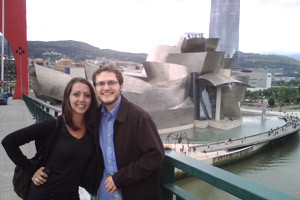
Summer in Madrid, 2011: When it comes to Grammar, There Are Still More Mountains to Climb
When I first saw a flier for UC's yearly
program, I hesitated to sign up. The trip, which takes place every summer quarter, offers four hours of daily language instruction at Madrids Don Quijote language institute (as well as several excursions and field trips) over six weeks. As an advanced Spanish student with three prior study abroad experiencesNicaragua, Mexico, and Chilealready under my belt, I wondered whether the Madrid program would be challenging enough for me. After all, I had already run through the gauntlet of UCs toughest Spanish grammar courses and emerged unscathed. When it came to grammar, I felt that there might not have been any more mountains left to climb. Nevertheless, the prospect of earning 18 credit hours in just six weeks was too tempting to pass up. I packed my bags and headed to Spain.
It took about one week at the Don Quijote language institute for me to realize just how much I didnt know about Spanish philology. To my surprise, I wasnt placed in the most challenging classon a scale that went A1, A2, B1, B2, C1, C2, I tested into the C1 rung. Yet even so, my professors withheld no punches when it came to grammar. When explaining various grammatical constructionsmany of which I had never seen beforethey rattled off the names of tenses and parts of speech at lightning speed, and we were expected to follow suit. The professors had a profound understanding of the more technical elements of language, and it wasnt long before I was speaking as they did; language was suddenly made up not just of nouns and verbs, but also of qualitative adjectives, directional verb compliments, adverbial locutions, paraphrasing verbs, and preterit-pluperfect constructions, and so on.
Vocabulary was just as intense, too. Just in our reading assignments alone, we were often hit with 20 or more new words per day. Over 30 days of instruction, that easily adds up to exposure to over 600 new words. We also learned dozens of figures of speech found in the argot of Spain. Thats not bad for one summer.
Of course, the trip to Madrid was about more than just classroom time. There were also our group sightseeing trips and our host family stays. And with nearly 40 students from the
in attendance, it was always easy to find someone to meet up with for a night on the town. I worked in some quality time with my professors, too, going out for coffee with the instructors from Don Quijote and heading for ice cream with UCs own Educator Assistant Professor Carl Bryant.
Even so, I feel that my best times in Madrid took place in the classroom. The level of the material the program covered was more advanced than any undergraduate Spanish course offered at UC, and it forced me to think about grammar in a more technical, more sophisticated way. When it was time to leave Madrid, I found some extra resources to help me continue to study the technical aspects of Spanish philology on my own. If I learned one thing in Madrid, it was that there are, indeed, more grammatical mountains left for me to climb.
In the past few months since the program has ended, I have had opportunities to employ my newfound perspective on language. My more technical way of viewing grammar proved useful one month later, when I headed to France as a tenderfoot in French. Already steeped in the parlance of philology professors, I was easily able to grasp the basic grammatical constructions of French, another romance language. Within a couple of weeks, I had learned enough grammar to hold a normal conversation in my new language.

Hilton and a group of UC students tour Toledo, Spain.
My newfound knowledge of Castilian figures of speech rendered me social dividends as well. While learning French, many of my classmates came from either Madrid or Barcelonaand when they spoke in Spanish, they employed the idioms of their home country with rigor. Having studied these expressions helped me fit in whenever our conversations drifted from French to Spanish over lunch or during breaks between classes.
Studying in Spain challenged me to deepen my understanding of Spanish while giving me an entirely new way to think about my major. The extra 18 hours of Spanish credit will allow me to graduate early, tooanother benefit of having gone on the trip. I would recommend this study abroad experience to anyone interested in pushing his or her knowledge of Spanish philology beyond what one can learn at UC.
Related Stories
UC offers experiential learning abroad in Central America
April 19, 2024
In the tropical paradise of Costa Rica, fourth year journalism and international affairs student Stephanie Rivera embarked on an unforgettable journey of self-discovery and cultural immersion. Leaving behind the familiar sights and sounds of Cincinnati, Rivera set out to study abroad for a transformative semester in this Central American country, rich with vibrant biodiversity and cultural heritage. The College of Arts & Sciences (A&S) at UC places great emphasis on encouraging study abroad and experiential learning opportunities for its students. Recognizing the transformative power of global experiences, the college supports a variety of study-abroad programs that enable students to enhance their academic pursuits while gaining valuable cultural and personal experiences.
WVXU: Test your word puzzle skills with a Cincinnati...
April 18, 2024
Cincinnati edition host Lucy May discusses the history and new found popularity of word games with Michael Griffith, professor English. Griffith is a writer, but also develops word games for publication.
Jason and Travis Kelce take Cincinnati to ‘New Heights’
April 16, 2024
UC alumni Jason and Travis Kelce returned to UC for an unforgettable evening that included the Great "Lombaby" Games, a live recording of their podcast "New Heights," special guests Joe Burrow, Orlando Brown Jr. and Desmond Ridder and a surprise commencement ceremony.
